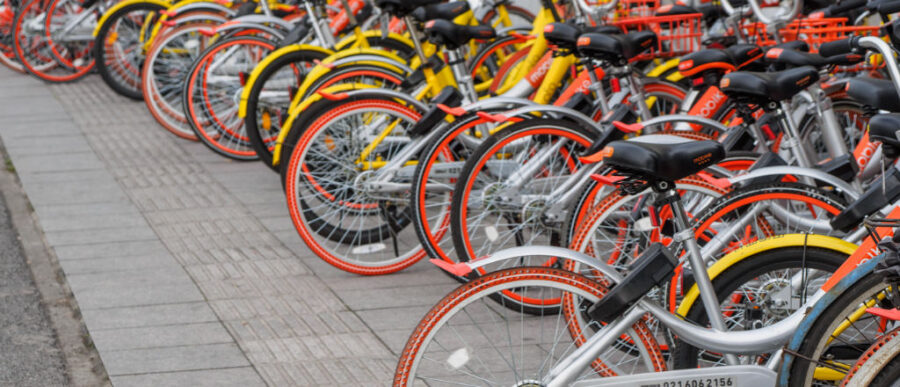Earlier this year, Wharton vice dean of entrepreneurship and innovation Karl Ulrich wrote an essay about the explosion of bike sharing in China. In this follow-up, he describes what he observed about the sector during recent trips to Beijing and the small city of Lhasa, Tibet, which he says provides an interesting contrast. He also examines some of the key developments taking place among bike sharing services in the U.S.
The fight for share has become ridiculously intense. Bike sharing now appears to be a two-bike race in China, with Mobike (the orange bike) and Ofo (the yellow bike) the leaders. In some locations in Beijing, there are literally a thousand bicycles lined up, half orange and half yellow. On this most recent trip, I never saw a time when there was not an oversupply of hardware on the street. Bluegogo (the blue bike) appears a distant third, which is too bad, because Bluegogo fields the best hardware, a factor apparently not very relevant in this phase of the race.
Cities have moved with lightning speed to establish infrastructure. Anyone who thinks of the Chinese government as slow and bureaucratic needs to revise their opinion, at least as related to this aspect of infrastructure. One venture capitalist told me: “The strategy of Mobike was to quickly gain widespread consumer adoption. There were no regulations initially. By the time the government woke up, the service was so popular it couldn’t be killed.” Another key factor is that Chinese Premier Li Ke Qiang openly endorsed the sharing economy in China. Cities snapped into action to improve infrastructure and the central government established regulations for the industry.
When I was in Beijing in March 2017, just six months ago, bike lanes were scarce and makeshift. Now, virtually every street has bike lanes with clear signage and physical separation from automobile traffic, usually implemented with quite robust steel fencing. A problem remains in that many motor scooters also use these lanes, and both cyclists and scooterists frequently travel the wrong direction — harrowing, but not as bad as being mixed in with automobile traffic. Even in Lhasa, Tibet, dedicated bike lanes (established mostly with painted lines) abound.
Cash requirements are crazy for the bike share start-ups in China. The market is a land grab, and feeding the land-grabbing beast is expensive. Over $2 billion in total venture capital has been poured into the industry to date. I took a group of students to Beijing this month to visit tech companies, and Mobike, while very politely declining my request for a visit, basically said they are going full throttle right now and can’t even take an hour of executive time to do anything but scale the business. I’m really impressed with these companies. The apps work very well, the bikes are neatly organized each morning, and I never encountered a hardware failure. Quite amazing.
“Anyone who thinks of the Chinese government as slow and bureaucratic needs to revise their opinion, at least as related to this aspect of infrastructure.”
Mobike Traction
Mobike reports that they are delivering 25 million rides per day. Twenty-five million rides per day — Whoa. While many start-ups exaggerate their traction by factors of two to 10, I find the Mobike figure credible. You can directly observe use of their service on the streets, even in remote parts of Lhasa. Ofo likely enjoys similar numbers. I can’t imagine anyone is making any money yet, but it seems clear that profits will eventually be achieved given the popularity of the service, the low cost of the hardware, and the higher volumes per company that will be inevitable as a result of organic growth in the user base and a shakeout among competitors.
The Importance of Density of Supply
I spent a week in Lhasa, Tibet for fun this month. Both Mobike and Ofo operate there. Lhasa has a population of only about 250,000 in the city itself. How can it possibly make sense for these companies to operate there? This is a classic case of strategic preemption. Incumbents enter fringe markets to deny new entrants the opportunity to ever get started, even if operating at this scale in a small market is not profitable for the incumbent when viewed in isolation. However, Mobike and Ofo have put relatively few bikes in service in Lhasa. I estimate there are only a thousand or so shared bikes on the road there. Furthermore, the city is not nearly as dense as first-tier cities in China. I found myself having to walk two or three minutes to find a bike in Lhasa, whereas in Beijing, a bike is pretty much always almost within an arm’s length.
In Lhasa, I saw a curious phenomenon – users are hogging the bikes. One evening, I identified the closest bike via the Mobike app only to find it locked with a personal u-lock. Of course, this behavior only makes sense if bikes are not always readily available. I never saw this behavior in Beijing; what would be the point?
“Virtually every street [in Beijing] has bike lanes with clear signage and physical separation from automobile traffic, usually implemented with quite robust steel fencing.”
Free Is a Compelling Price
The competition for share in China is fierce right now. Mobike (and I suspect Ofo) are essentially free right now for trips of less than 20 minutes. (Mobike explicitly offers its service for free for the first 30 days, but there are so many promotions, that I bet most people are not paying much, if anything, even beyond the trial period. Even at regular list prices, a trip costs just 1 RMB (about 0.15 USD). This pricing has a transformative effect on use patterns. In Beijing I found myself using the bike for trips as short as two blocks — really almost never walking. As a bike lover, I never imagined I would live in a world in which a bike was virtually always available in seconds and could be left and forgotten within a few meters of my final destination.
Chongqing and Hills
The tiny city of Lhasa in Tibet benefits from the presence of both Ofo and Mobike. But the same is not the case in Chongqing, a first-tier city in southern China. Why not? Easy: Chongqing is hilly. This is compelling empirical evidence for just how important terrain is in explaining consumer adoption of bicycling for personal transportation.
In hilly U.S. cities we are starting to see an electric assist bike sharing. (Disclosure: I am an investor in Social Bicycles, which pioneered station-less bike sharing, and has recently launched an electric-assist service called JUMP.) While there are some early electric-assist systems in China, they seem to be low-quality bikes offered by fringe competitors. This will change, and most likely “pedelecs” will be introduced in Chongqing and other hilly cities globally in the coming months. Electric bikes of course require recharging, an additional complication. Social Bicycles has dealt with this challenge by providing a financial incentive (e.g., a discount) to users who return bikes to designated charging stations.
“As a bike lover, I never imagined I would live in a world in which a bike was virtually always available in seconds and could be left and forgotten within a few meters of my final destination.”
U.S. Update
Station-less bike share is emerging as the dominant concept for bike share systems and will likely diffuse in the U.S. in a significant way. Ironically in the land of liberty, government regulation is a primary obstacle. I do believe regulation is important or we’ll have massive chaos in our otherwise most attractive cities. San Francisco now has a clear permitting process, and several other municipalities are following suit. Social Bicycles is now live with its JUMP electric bikes in San Francisco and Washington, D.C. Spin has launched in Seattle and San Francisco. Lime operates in several U.S. locations. Mobike launched this month in Washington, D.C. (Wikipedia provides a comprehensive list of bike systems globally, although most of these systems are kiosk-based.)
The U.S. is a significantly different market than China. Other than New York City, U.S. cities are not as population dense as those in China, which may make bikes less available on every street corner. However, while transportation pain for consumers in Boston is not as acute as in Beijing, U.S. users may also be willing to pay $1 or more per ride compared to 15 cents USD per ride in China. Higher prices allow companies to deploy a higher-quality bike, using smoother pneumatic tires, perhaps providing a display of some kind, offering a choice of gears, and allowing for greater size adjustment. Many key U.S. cities do have challenging terrain (e.g., Seattle, San Francisco). My guess is that electric-assist bicycles will therefore play an important role in the U.S. A year from now what is going to work in the U.S. should be a lot clearer.
I have been fascinated by personal transportation my whole life, and so watching these developments is for me really exciting. Seemingly modest improvements in GPS, mobile computing and internet connectivity have quite suddenly enabled a revolution in transportation. There will be bumps in this road, but the wind is finally at our backs.
Appendix: How to Set up Bike Sharing as a Foreigner in China
(The WeChat and payments ecosystem is changing almost weekly in China. This is the best information I have as of September 2017.)
“Seemingly modest improvements in GPS, mobile computing and internet connectivity have quite suddenly enabled a revolution in transportation.”
You probably will need access to a Chinese mobile phone number. Most Chinese cell phones are pay-as-you-go. You simply buy a SIM card, with an associated phone number. You can do that at any mobile phone shop, which are in storefronts in every neighborhood. To purchase a SIM card you will need your passport, and the sales person will probably take a photograph of you holding your open passport next to your face. You then top-up your account either by paying cash in a physical store when you need more credit (they then make a payment to your account on your behalf) or, more typically, you or a friend will send a WeChat payment to your mobile phone number. This is trivially simple once you figure it out. In China, you can buy a low-end Android phone for as little as 1300 RMB (around $200 USD), which is probably a good idea if you spend significant time in China. This allows you to have a separate Chinese mobile device without messing with your “home” phone. You need the China mobile number to receive confirmation texts for most financial services in China, including registering bike sharing apps. (Of course, you could borrow a friend’s mobile phone and install your SIM card in their device if you just need to receive one or two confirmation texts.)
If you are spending any significant time in China, you already use WeChat. Connecting WeChat to a payment method is quite important in China. Pretty much everything is paid for with WeChat. Almost no one uses cash. Yet, this is tricky for foreigners. If you are only spending limited time in China, the easiest thing to do is hand a friend a wad of cash and have them send to your WeChat account a “red envelope” (i.e., hong bao) containing the corresponding value. Once you open the red envelope you’ll have a balance that you can use to make payments in WeChat. (If you spend a lot of time in China, open a Chinese bank account. However, even if you speak conversational Chinese, I recommend you have a native-speaking friend help you. I found the process pretty challenging. You’ll need your passport and that Chinese mobile phone. You can then link WeChat to your Chinese debit card.)
You should now be able to download the bike share apps, register with your Chinese cell phone and your passport number, and then pay for the deposit with WeChat. I’ve only used Mobike, which has an excellent English language version of their app, perhaps because they now operate in several English-speaking countries. Mobike is ubiquitous, so a good choice. The only problem is that the bike seat on most Mobike bikes cannot be extended far enough for riders taller than about 175cm (5’ 9”) – still ridable for short distances, but not ideal.
Mastering Innovation: From Idea to Value Creation
Become the catalyst for company-wide change when you learn how to construct the architecture that drives innovation in an organization.
Learn more.



